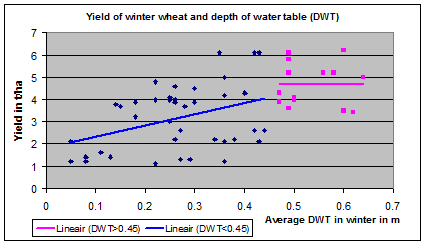
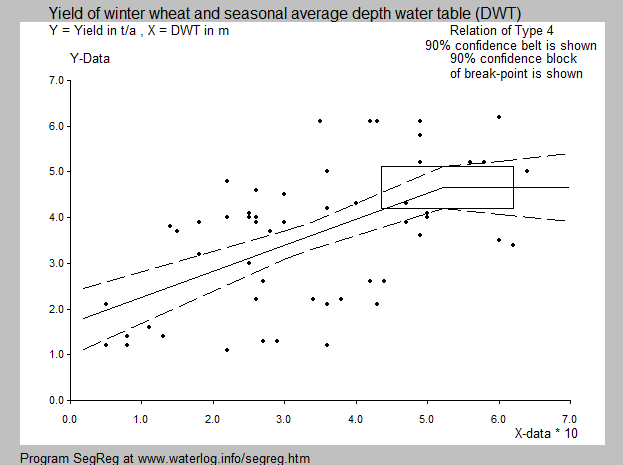
|
The cases below are a representation of what could be
found in literature on the relation between crop yield
and seasonal average depth of the water table (DWT)
measured in farmers' fiels.
Such data are relatively scarce. Some of the data were collected before in this publication on drainage criteria Many crops lose their productivity when the water table is too shallow and the soil is waterlogged. The shallowest permissible depth at which no yield reduction occurs can be called critical water table depht and, it can serve as a drainage criterion. The establishment of a water table deeper than the critical depth is more costly and not strictly necessary. See also this article on cautious drainage. Data collected in farmers' fields often show considerable scatter (random variation). One will need statistical methods to interpret the data relationships. This may be done using Excel worksheets finding by eye estimate the watertable range over which there is no effect, i.e. the relation between yield and DWT is practically horizontal, and the range below that, where the yields decline as the water table becomes shallower and more waterlogged. The separation point between the two ranges may be called critical DWT, because only below this value the yield is negatively affected. Another way is using a calculator for segmeneted regression like SegReg As the water table normally shows fluctutations in time, the seasonal average depth of the watertable needs to be determined as the average of a large enough number of observations throughout the growing season to obtain a reasonably representative value. For the maxiumum possible "no effect" range one may consult PartReg instead of SegReg. A discussion on methods to analyse data on crop yield and depth of watertable measured in farm lands can be consulted at ResearchGate or on this web site |
Software & models Articles & manuals Reports case studies FAQ's & answers Home page Contact form |
|
 |
| The winter wheat is sown before wintertime sets in. In winter it starts its vegatative development, but maturation and harvest occur in summer. The water table depth (DWT) in summer is usually deep enough not to pose a problem. However, in winter, shallow water tables and waterlogging may occur, and the data, interpreted with Excel, illustrate that a DWT < 0.45 m during winter causes yield reductions while there is no effect when DWT > 0.45 m. |
 |
| Analysis of the same data with SegReg confirms the findings from Excel, but it puts the critical depth at 0.52 m instead of 0.45. The width of the confidence belt indicates that there is no statistical difference. |
|
2 - Sugarcane, Australia Reference: Rudd, A.V. and C.W Chardon 1977. The effects of drainage on cane yields as measured by water table height in the Machnade Mill area. In: Proceedings of the 44th Conference of the Queensland Society of Sugar Cane Technology, Australia. |
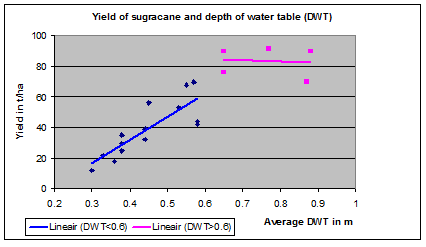 |
| Sugarcane is a crop that needs at least a 9-month growing season if not 1 year or more. The data, interpreted with Excel, illustrate that a DWT < 0.60 m during winter causes yield reductions while there is no effect when DWT > 0.60 m. |
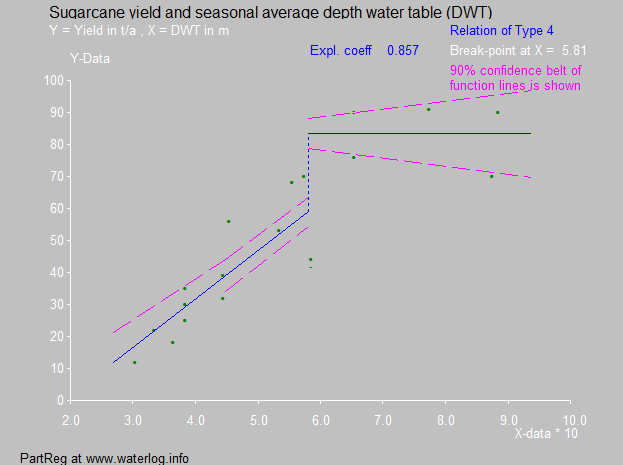 |
| Analysis of the same data with PartReg confirms the findings from Excel and it puts the critical depth also at 0.6 m. |
|
3 - Banana, Surinam Reference: Lenselink, K.J. 1972. Drainage requirements for banana in the coastal plain (in Dutch, title translated by author). De Surinaamse Landbouw, Vol. 20, pp. 22-36. |
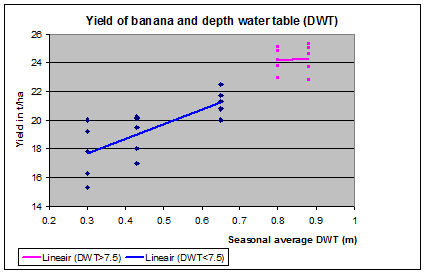
|
| The banana plantations investigated in Surinam show, in this Excel analysis, a clear yield decline at DWT < 0.70 m while at DWT values > 0.80 m there is no more yield reduction and the yield stays stable. This is the range of "no effect". |
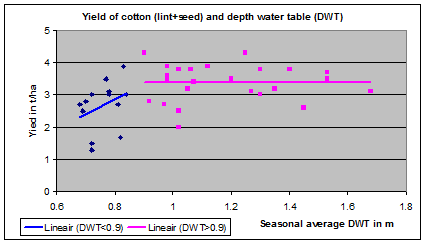
|
| Analysis of the same data with PartReg confirms the findings from Excel. The number of data with DWT > 0.7 is limited so that a precise critical depth of the water table cannot be determined. |
|
4 - Cotton, Egypt Reference: Nijland, H.J. and S. El Guindy 1984. Crop yields, soil salinity and water table depth in the Nile Delta. In: ILRI Annual Report 1983, Wageningen, pp. 19-29, see on line |

|
| The field measurements of cotton yield in the irrigated lands of the Nile Delta, Egypt, when analysed with Excel, show a strong yield reductions at water table depths < 0.9 m whereas above this level there is no more yield decline and the yield stays stable at its maximum. This is the range of "no effect". |
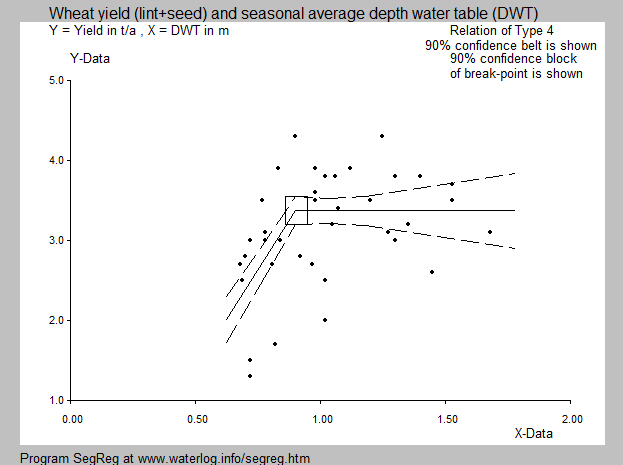
|
| Analysis of the same data with SegReg confirms the findings from Excel. The number of data with DWT > 0.9 is fairly large and the minimum tolerable water table depth can be pinpointed quite precisely. This cotton crop is apparently planted in a region with deep water tables selected by famers who know the sensitivity of cotton to high water levels and waterlogging. |
| CROP | TOLERANCE | CLASSIFICATION |
| DWT in m | ||
| Wheat, England | 0.45 | Very tolerant |
| Sugar cane, Australia | 0.60 | Tolerant |
| Banana, Surinam | 0.70 | Sligtly sensitive |
| Cotton, Egypt | 0.90 | Sensitive |